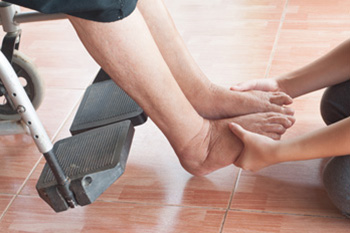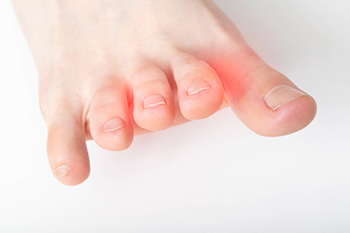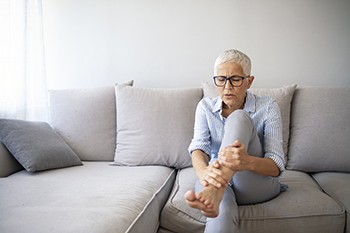
The feet are the base of our body. They carry our weight and get us from place to place. The older one is, the more wear and tear of life will show up on their feet. The feet change as people age, so it is common that foot padding is thinner and does not provide the cushioning of younger years. More pain may be felt in the foot and heel because of this. A senior may be prone to Morton's neuroma, which is a thickening of the nerve between the third and fourth toe on the bottom of the foot. It may feel like walking on a pebble, and it can be painful. Cracked heels is yet another common plague of aging. Mature skin has less oil and is drier. The skin on the feet may harden, crack, and hurt. In severe cases, fissures may develop, and care has to be taken to prevent potential infections. If you are older, it is suggested that you include a podiatrist on your health care team. This foot care expert can examine your feet regularly, teach you how to prevent foot problems from happening, and treat any that do occur.
If you need your feet checked, contact Dr. Richard DiMario of Maine. Our doctor will attend to all of your foot and ankle needs and provide you with quality treatment.
Geriatrics and Podiatry
When people age, some common issues that may occur are bone density loss, dry skin, poor circulation, and rough brittle nails. These issues may also affect your foot health if the necessary steps are not taken to alleviate the problems.
It is important to take care of your feet because feet that are injured or diseased can affect your overall health. Having painful feet hinders your ability to do daily activities or may decrease your willingness to do the things that you need to do.
Visiting Your Geriatrician
As we age, health problems become more likely, so it is essential to visit your doctor for check-ups to ensure that you are doing the best you can to take care of your health. It is recommended to check your feet frequently for any possible cuts, bruises, swelling, corns or any other irregularities.
Taking Care of Elderly Feet
Cracked or dry feet can be treated by applying moisturizer often. It is also important not to wear old socks because the older the sock is, the higher the possibility there will be that there is bacteria there. Wear fresh socks and make sure they fit properly.
Proper foot health means that you can have a more active lifestyle and you will not be bogged down by pain. Foot health also leads to good circulation, which is paramount for overall health.
If you have any questions, please feel free to contact our office located in York, ME . We offer the newest diagnostic tools and technology to treat your foot and ankle needs.

A compressed or irritated growth that is found between the third and fourth toes can represent a foot condition known as Morton’s neuroma. It is considered to be benign, despite how painful it can be. Wearing shoes that do not have enough room for the toes to move freely can be a common cause for this condition to occur. High heels fit into this category, and women who frequently wear this type of shoe may be affected. People who are afflicted with this ailment often feel they have a small pebble in their shoe or sock, typically on the ball of the foot. This part of the foot is used for standing and walking, which can cause constant pain. Patients who notice the beginning signs of Morton’s neuroma may find temporary relief when better shoes are worn. For more severe cases, it is suggested that you consult with a podiatrist who can provide you with permanent relief solutions.
Morton’s neuroma is a very uncomfortable condition to live with. If you think you have Morton’s neuroma, contact Dr. Richard DiMario of Maine. Our doctor will attend to all of your foot care needs and answer any of your related questions.
Morton’s Neuroma
Morton's neuroma is a painful foot condition that commonly affects the areas between the second and third or third and fourth toe, although other areas of the foot are also susceptible. Morton’s neuroma is caused by an inflamed nerve in the foot that is being squeezed and aggravated by surrounding bones.
What Increases the Chances of Having Morton’s Neuroma?
Morton’s neuroma is a very treatable condition. Orthotics and shoe inserts can often be used to alleviate the pain on the forefront of the feet. In more severe cases, corticosteroids can also be prescribed. In order to figure out the best treatment for your neuroma, it’s recommended to seek the care of a podiatrist who can diagnose your condition and provide different treatment options.
If you have any questions, please feel free to contact our office located in York, ME . We offer the newest diagnostic and treatment technologies for all your foot care needs.

Arthritis is an inflammatory disease that causes pain in the joints. Because each foot consists of 33 joints that can become inflamed, it may be helpful to find shoes that help to provide some relief from arthritic foot pain. Experts recommend wearing a shoe with a sturdy sole, as those with a softer sole may increase the pressure on the heel with each step. It is beneficial to look for a shoe that bends only near the toes and does not fold in half when squeezed. Further, avoiding shoes with narrow or pointed-toe boxes is thought to be the best choice. In addition, shoes with removable insoles are recommended, as this can make it easier to add custom insoles if needed. These inserts can support weakened joints, improve mobility, and reduce pain. High-heeled shoes or flats are not recommended for people with arthritis. Instead, finding shoes with a slight incline from toe to heel is thought to be better. For more information on selecting footwear for arthritic feet, it is suggested that you consult a podiatrist.
Arthritis can be a difficult condition to live with. If you are seeking treatment, contact Dr. Richard DiMario from Maine. Our doctor can provide the care you need to keep you pain-free and on your feet.
Arthritic Foot Care
Arthritis is a joint disorder that involves the inflammation of different joints in your body, such as those in your feet. Arthritis is often caused by a degenerative joint disease and causes mild to severe pain in all affected areas. In addition to this, swelling and stiffness in the affected joints can also be a common symptom of arthritis.
In many cases, wearing ill-fitting shoes can worsen the effects and pain of arthritis. Wearing shoes that have a lower heel and extra room can help your feet feel more comfortable. In cases of rheumatoid arthritis, the arch in your foot may become problematic. Buying shoes with proper arch support that contour to your feet can help immensely.
Alleviating Arthritic Pain
It is best to see your doctor for the treatment that is right for your needs and symptoms. Conditions vary, and a podiatrist can help you determine the right method of care for your feet.
If you have any questions, please feel free to contact our office located in York, ME . We offer the newest diagnostic tools and technology to treat your foot and ankle needs.

Practicing proper safety measures in the workplace is crucial in preventing accidents. This can begin with foot safety and wearing the right shoes during the workday can help to accomplish this. It is beneficial to ensure the shoes worn are slip-resistant, constructed of durable materials, and have adequate arch support. Some jobs require extra foot protection. This can consist of wearing safety boots that have a steel tip. It is helpful to take breaks as often as possible, as this can provide an opportunity to rest and stretch the feet. As the feet are stretched, blood flow may be improved, which can help to prevent injuries and fatigue. Maintaining proper foot hygiene may help to prevent infections, and it is advantageous to inspect the feet for signs of irritation. If you would like more information about how to protect your feet during the workday, it is suggested that you consult with a podiatrist who can offer you helpful tips.
While working on the feet, it is important to take the proper care of them. For more information about working on your feet, contact Dr. Richard DiMario from Maine. Our doctor will treat your foot and ankle needs.
Working on Your Feet
Standing on your feet for long periods of time can cause stress and pain in your feet. Your whole body may experience change in terms of posture, back pain, bunions, callouses and or plantar warts. There are ways to avoid these conditions with proper foot care, smart choices and correct posture.
Positive Changes
Negative heeled shoe – Choosing this shoe type places the heel slightly lower than the ball of the foot. These are great for overall foot health. Find shoes that fit you correctly.
Go barefoot – Our feet were not designed to be enclosed for all hours of the day. Try to periodically expose your feet to air.
Eliminate Pain
Foot Exercises – Performing simple exercises, incorporating yoga and doing stretches are beneficial. This will allow increased blood flow to the area and muscles of the foot.
Achilles tendon – Stretching the foot out flat on the floor will relax the calf muscles and tendon. These exercises can be performed almost anywhere. Make sure you add these exercises to your daily regimen.
With a little bit of this information and knowing more about foot health, you will notice changes. Foot stretches and proper footwear will help with pain and prevent further issues.
If you have any questions please feel free to contact our office located in York, ME . We offer the newest diagnostic and treatment technologies for all your foot and ankle needs.

A foot is fractured when any of the bones located in the foot become broken. As a result, the foot may be painful, and it can be difficult to put weight on it. There are many different reasons why the foot might fracture. For example, since humans use their feet everyday for significant periods of time, the feet are susceptible to slipping and twisting. Thus, the bones in the feet can break. They also can develop stress fractures from repetitive pounding during activities that involve running. Due to their close proximity to the ground, the feet can likely be impacted by heavy objects falling that can cause fractures. Of course, a foot might fracture due to some kind of sports injury, as well. If you are someone who has fractured their foot, it is suggested that you immediately schedule an appointment with a podiatrist who can provide treatment options.
A broken foot requires immediate medical attention and treatment. If you need your feet checked, contact Dr. Richard DiMario from Maine. Our doctor can provide the care you need to keep you pain-free and on your feet.
Broken Foot Causes, Symptoms, and Treatment
A broken foot is caused by one of the bones in the foot typically breaking when bended, crushed, or stretched beyond its natural capabilities. Usually the location of the fracture indicates how the break occurred, whether it was through an object, fall, or any other type of injury.
Common Symptoms of Broken Feet:
Those that suspect they have a broken foot shoot seek urgent medical attention where a medical professional could diagnose the severity.
Treatment for broken bones varies depending on the cause, severity and location. Some will require the use of splints, casts or crutches while others could even involve surgery to repair the broken bones. Personal care includes the use of ice and keeping the foot stabilized and elevated.
If you have any questions please feel free to contact our office located in York, ME . We offer the newest diagnostic and treatment technologies for all your foot and ankle needs.